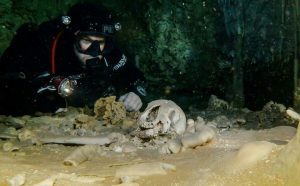Archaeologists exploring recently discovered world’s largest underwater cave, located in Sac Actun and Dos Ojos, Mexico, discovered Maya relics and remains of Pleistocene fauna.

Two large networks of underwater caves of Sac Actun and Dos Ojos were found connected last month by researchers, forming world’s largest underwater cave network known to man. Researchers of Mexico’s National Institute of Anthropology and History (INAH) have been exploring the area for ancient relics. They believe that water has fluctuated over time, and that they were a source of water in times of severe drought. So far among finds made in the cave are remains of animals dating all the way back to the Pleistocene epoch (between 2.6 million to 11700 years ago), and artefacts left inside by humans: burnt human bones, ceramics, wall etchings and more.

The relics found within the cave network include a shrine to the Mayan god of war and commerce, with a staircase accessed through a sink-hole in the middle of the jungle. According to the archaeologists, many other of the hundreds of sink-holes that connect to the cave have elaborate signs of ritual activity around them, archaeologists said. They believe that the ancient Mayans viewed caves as extremely sacred places, especially ones that led to water.
(after PhysOrg & National Institute of Anthropology and History)